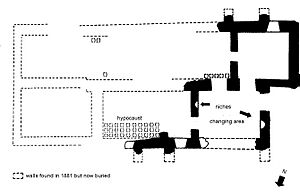Ravenglass Roman Bath House facts for kids
The Ravenglass Roman Bath House, also called Walls Castle, is an old Roman bath house that is now in ruins. It is located in Ravenglass, Cumbria, England.
This bath house was part of a Roman fort and naval base built in the 2nd century. The Romans called this place Glannoventa. Experts say the bath house is "an astonishing survival" because its walls are still standing 13 feet (4 meters) high! You can even see bits of the original red and white plaster on the inside walls. There are also signs of where the windows used to be.
What we see today is just one part of the original building. It was about 40 feet (12 meters) wide and 90 feet (27 meters) long. The bath house had many rooms lined up in two rows. There was an entrance and a changing room, called an apodyterium. This room had special spots, or niches, that might have held statues. We don't know what all the other rooms were used for. But there would have been warm rooms, a hot bath, and a cold pool. The outer walls had strong supports called buttresses. These probably helped hold up a curved, vaulted roof.
People dug up the bath house in 1881. They found parts of the hypocaust heating system. This was how the Romans heated their baths from underneath the floor! However, these parts have since been covered up again.
The Roman Fort at Ravenglass
The bath house is found just outside the main Roman fort. The fort's defenses were first made from earth and wood. But in the early 3rd century, the Romans built a strong stone wall. The fort was used continuously from about AD 130 until the end of the 4th century. This means it was active for over 250 years!
Water for the bath house likely came from higher ground to the east of the fort. Because the bath house was outside the fort walls, some people think it was used by local people as well as the soldiers. Before 2013, not much was known about the civilian town, or vicus, at Ravenglass.
Protecting This Ancient Site
The bath house is still in such good shape because it was used as a home in the Middle Ages. People realized it was Roman in the 1800s. At first, they thought it was a Roman villa, which is like a fancy house. But later, in the 1900s, they figured out it was actually a bath house.
Today, the Ravenglass Roman Bath House is a protected site called an Ancient Monument. It is looked after by English Heritage. It is also part of the Frontiers of the Roman Empire World Heritage Site.
You can visit the bath house from Ravenglass. There's a special walking path called "miles without stiles." This path helps people with disabilities explore the Lake District National Park. The path follows a private road next to the railway tracks. You can see the ditch of the old fort from the bath house. However, that part is on private land and is cut through by the railway.



